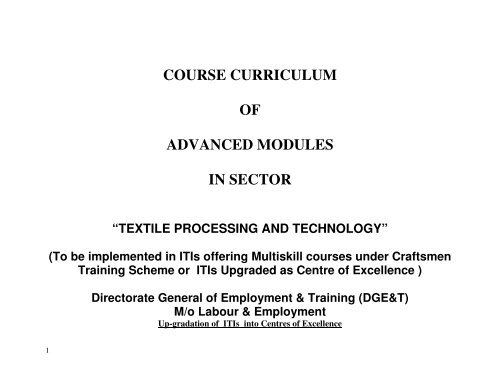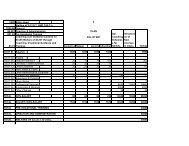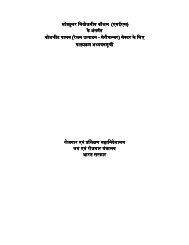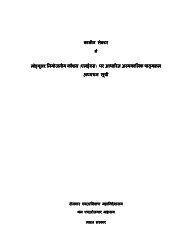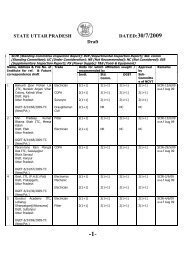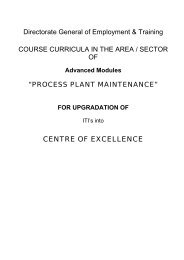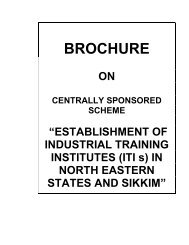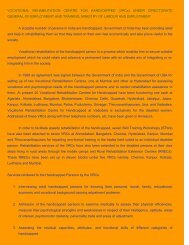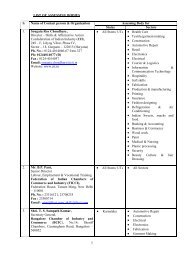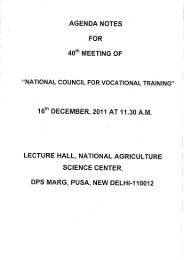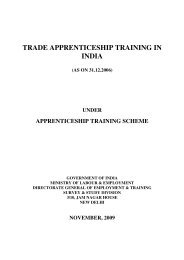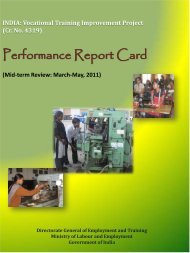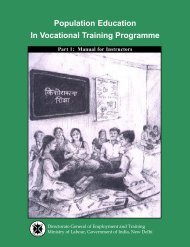course curriculum of advanced modules in sector - Directorate ...
course curriculum of advanced modules in sector - Directorate ...
course curriculum of advanced modules in sector - Directorate ...
Create successful ePaper yourself
Turn your PDF publications into a flip-book with our unique Google optimized e-Paper software.
COURSE CURRICULUM<br />
OF<br />
ADVANCED MODULES<br />
IN SECTOR<br />
“TEXTILE PROCESSING AND TECHNOLOGY”<br />
(To be implemented <strong>in</strong> ITIs <strong>of</strong>fer<strong>in</strong>g Multiskill <strong>course</strong>s under Craftsmen<br />
Tra<strong>in</strong><strong>in</strong>g Scheme or ITIs Upgraded as Centre <strong>of</strong> Excellence )<br />
<strong>Directorate</strong> General <strong>of</strong> Employment & Tra<strong>in</strong><strong>in</strong>g (DGE&T)<br />
M/o Labour & Employment<br />
Up-gradation <strong>of</strong> ITIs <strong>in</strong>to Centres <strong>of</strong> Excellence<br />
1
Broad Guidel<strong>in</strong>es for Implementation <strong>of</strong> Advanced Module <strong>in</strong> Sector<br />
“ TEXTILE PROCESSING AND TECHNOLOGY ”<br />
These Centres will be provid<strong>in</strong>g multi-skill tra<strong>in</strong><strong>in</strong>g to meet skill requirement <strong>of</strong> TEXTILE INDUSTRY with their<br />
active <strong>in</strong>volvement <strong>in</strong> all aspects <strong>of</strong> tra<strong>in</strong><strong>in</strong>g. The tra<strong>in</strong><strong>in</strong>g will be provided <strong>in</strong> three parts as given below.<br />
Broad Based Basic Tra<strong>in</strong><strong>in</strong>g (<strong>of</strong> Six Modules) <strong>in</strong> Basic skill areas for a period <strong>of</strong> one year.<br />
Tra<strong>in</strong><strong>in</strong>g <strong>in</strong> Advanced Modules for the First Six Months duration <strong>of</strong> II nd year after Broad Based Basic<br />
Tra<strong>in</strong><strong>in</strong>g (BBBT)<br />
Test<strong>in</strong>g & Certification both for the Broad Based Basic Tra<strong>in</strong><strong>in</strong>g (BBBT) & Advanced Modules Tra<strong>in</strong><strong>in</strong>g<br />
dur<strong>in</strong>g subsequent Six Months will be conducted under the aegis <strong>of</strong> NCVT.<br />
Tra<strong>in</strong><strong>in</strong>g <strong>in</strong> specialized <strong>modules</strong> (for the Second Six Months duration <strong>of</strong> II nd year) ma<strong>in</strong>ly by the <strong>in</strong>dustry.<br />
( The <strong>course</strong> curricula ,duration etc are designed <strong>in</strong> consultation with the IMC ). The trade test<strong>in</strong>g &<br />
certification for specialized <strong>modules</strong> will be done jo<strong>in</strong>tly by the State Government & Industry. Said<br />
Certificate will have reorganization from NCVT.<br />
As per the recommendations <strong>of</strong> the EFC , Tra<strong>in</strong><strong>in</strong>g <strong>in</strong> the shop floor should constitute at least 25-40% <strong>of</strong> the<br />
<strong>curriculum</strong>.<br />
2
The tra<strong>in</strong><strong>in</strong>g programme will have multi-entry and multi-exit provision as given below :<br />
Tra<strong>in</strong>ee can opt to go to the labour market after complet<strong>in</strong>g broad based basic tra<strong>in</strong><strong>in</strong>g <strong>of</strong> one year<br />
duration or after complet<strong>in</strong>g <strong>advanced</strong> <strong>modules</strong>.<br />
Multi-entry and multi-exit provision would enable a tra<strong>in</strong>ee to take admission for <strong>advanced</strong> / additional<br />
<strong>advanced</strong> / specialized module as per his/ her need.<br />
Guidel<strong>in</strong>es for tra<strong>in</strong><strong>in</strong>g <strong>in</strong> Advanced Modules<br />
A m<strong>in</strong>imum <strong>of</strong> three <strong>modules</strong> would be essentially needed , so as to ensure that all the 96 tra<strong>in</strong>ees are<br />
accommodated <strong>in</strong> the three Modules , may be selected <strong>in</strong> consultation with IMC for which <strong>in</strong> two shifts.<br />
If it is felt that available <strong>modules</strong> for which the <strong>course</strong> curricula has been developed at National Level are<br />
not sufficient to cater to the needs <strong>of</strong> Local Industry <strong>in</strong> a particular State , States are free to select Module<br />
as per need <strong>in</strong> consultation with Industry. They may develop suitable Module (s) accord<strong>in</strong>gly.<br />
A tra<strong>in</strong>ee at a time can opt only for One Advanced Module.<br />
<br />
Admission Criteria , Space requirement , Qualification <strong>of</strong> Instructor <strong>of</strong> the various Advanced<br />
Modules <strong>of</strong> “ TEXTILE PROCESSING & TECHNOLOGY ” Sector are given below :<br />
3
Module<br />
No.<br />
Name <strong>of</strong> the Modules Admission Criteria Space<br />
Requirement<br />
ATPT-04 Advanced Textile<br />
Completed BBBT <strong>in</strong> 1. 80 Sq.mtr. for<br />
Technology<br />
Textile Process<strong>in</strong>g and Each Advanced<br />
Technology or or NTC Module &<br />
/NAC <strong>in</strong> related trade or height <strong>of</strong><br />
Diploma <strong>in</strong> Textile<br />
workshop<br />
Technology<br />
should be m<strong>in</strong>.<br />
ATPT-05 Technology <strong>of</strong> Siz<strong>in</strong>g , Completed BBBT <strong>in</strong> 5 mtr.<br />
Bleach<strong>in</strong>g and F<strong>in</strong>ish<strong>in</strong>g Textile Process<strong>in</strong>g and 2. 20 Sq. mtr. For<br />
Technology or or NTC Dark Room<br />
/NAC <strong>in</strong> related trade or Studio<br />
Diploma <strong>in</strong> Textile<br />
Technology<br />
ATPT-06 Technology <strong>of</strong> Dye<strong>in</strong>g Completed BBBT <strong>in</strong><br />
Textile Process<strong>in</strong>g and<br />
Technology or or NTC<br />
/NAC <strong>in</strong> related trade or<br />
Diploma <strong>in</strong> Textile<br />
Technology<br />
ATPT-07 Technology <strong>of</strong> Pr<strong>in</strong>t<strong>in</strong>g Completed BBBT <strong>in</strong><br />
Textile Process<strong>in</strong>g and<br />
Duration <strong>in</strong><br />
weeks<br />
26 Weeks<br />
for<br />
Each<br />
Advanced<br />
Module<br />
Qualification <strong>of</strong> Instructor<br />
Degree <strong>in</strong> Textile Technology<br />
with m<strong>in</strong>imum two years<br />
teach<strong>in</strong>g / <strong>in</strong>dustrial experience<br />
<strong>in</strong> the relevant field. OR<br />
Diploma <strong>in</strong> Textile Process<strong>in</strong>g<br />
& Technology with m<strong>in</strong>imum<br />
five years teach<strong>in</strong>g / <strong>in</strong>dustrial<br />
experience <strong>in</strong> the relevant field.<br />
4
ATPT-08 Computer Aided Textile ,<br />
Design & Colour<br />
ATPT-09 Test<strong>in</strong>g <strong>of</strong> Chemicals and<br />
Textiles<br />
Technology or or NTC<br />
/NAC <strong>in</strong> related trade or<br />
Diploma <strong>in</strong> Textile<br />
Technology<br />
Completed BBBT <strong>in</strong><br />
Textile Process<strong>in</strong>g and<br />
Technology or or NTC<br />
/NAC <strong>in</strong> related trade or<br />
Diploma <strong>in</strong> Textile<br />
Technology<br />
Completed BBBT <strong>in</strong><br />
Textile Process<strong>in</strong>g and<br />
Technology or or NTC<br />
/NAC <strong>in</strong> related trade or<br />
Diploma <strong>in</strong> Textile<br />
Technology<br />
5
FEE STRUCTURE : Fee Structure may be decided by States Govt. <strong>in</strong> consultation with IMCs . It may be desirable to<br />
prescribe a uniform tuition fee for a <strong>sector</strong> <strong>in</strong> all Centres <strong>of</strong> Excellence <strong>of</strong> a state.<br />
EMLOYMENT OPPORTUNITIES IN TEXTILE PROCESSING & TECHNOLOGY SECTOR<br />
JOB OPPORTUNITIES :<br />
a) Supervisor/ Incharge <strong>in</strong> Sp<strong>in</strong>n<strong>in</strong>g , Weav<strong>in</strong>g , Bleach<strong>in</strong>g, Dye<strong>in</strong>g, Pr<strong>in</strong>t<strong>in</strong>g, F<strong>in</strong>ish<strong>in</strong>g departments <strong>in</strong> Textile Mills.<br />
b) Technical Assist<strong>in</strong>g <strong>in</strong> Laboratory/Research and Development sections <strong>of</strong> textile chemical process<strong>in</strong>g units.<br />
c) Technician / Technical Assistant <strong>in</strong> textile committees, textile corporations, small scale <strong>in</strong>dustry organisation, and handloom<br />
<strong>in</strong>dustry.<br />
d) Technical Representatives manufacturers for Dyestuffs/textile auxiliaries.<br />
e) An entrepreneur <strong>of</strong> a textile process<strong>in</strong>g unit/ dyestuffs <strong>in</strong>dustry.<br />
COMPETENCY PROFILE IN TEXTILE PROCESSING & TECHNOLOGY SECTOR<br />
A Technician <strong>in</strong> textile process<strong>in</strong>g & technology should have follow<strong>in</strong>g competencies:-<br />
1. Knowledge and skills perta<strong>in</strong><strong>in</strong>g to fibre, yarn, dyes and chemicals: their characteristics, preparation, specifications and usage.<br />
2. Knowledge and skills <strong>of</strong> various process<strong>in</strong>g mach<strong>in</strong>es required for process<strong>in</strong>g <strong>of</strong> textiles <strong>in</strong> bleach<strong>in</strong>g; dye<strong>in</strong>g, pr<strong>in</strong>t<strong>in</strong>g and f<strong>in</strong>ish<strong>in</strong>g<br />
sections and upkeep <strong>of</strong> mach<strong>in</strong>ery.<br />
3. Competencies <strong>in</strong> textile designs and Knowledge <strong>of</strong> types, comb<strong>in</strong>ations, application and evaluation <strong>of</strong> colours.<br />
4. Competency to undertake test<strong>in</strong>g <strong>of</strong> fibre and yarn and fabrics and dyes understand<strong>in</strong>g various quality control operation and ability<br />
to <strong>in</strong>spect f<strong>in</strong>ished goods.'<br />
5. Competency to prepare material, equipment and manpower schedule for process<strong>in</strong>g <strong>of</strong> textile <strong>in</strong> various sections<br />
6. Awareness <strong>of</strong> environmental pollution due to textile process<strong>in</strong>g, procedure to control position and waste disposals and pollution<br />
6
Act.<br />
7. Ability to tackle simple shop floor related problems <strong>in</strong> the field <strong>of</strong> textile process<strong>in</strong>g.<br />
8. Basic skills <strong>in</strong> read<strong>in</strong>g draw<strong>in</strong>g<br />
RECOMMENDATIONS FOR EFFECTIVE IMPLEMENTATION OF CURRICULUM<br />
The follow<strong>in</strong>g recommendations are made for effective implementation <strong>of</strong> this <strong>curriculum</strong>. :<br />
a) While impart<strong>in</strong>g <strong>in</strong>structions, stress should be laid on the development <strong>of</strong> practical skills <strong>in</strong> the tra<strong>in</strong>ees. For this purpose, as far as<br />
possible, classes should be conducted <strong>in</strong> the laboratories itself.<br />
b) Industrial visits should be organized as and when required to clarify the concepts, pr<strong>in</strong>ciples and practices <strong>in</strong>volved. For this<br />
purpose, time has already been provided <strong>in</strong> tra<strong>in</strong>ees centered activities<br />
c) Extension lectures from pr<strong>of</strong>essionals should be organized to impart <strong>in</strong>structions <strong>in</strong> specialized areas<br />
d) There is no need <strong>of</strong> purchas<strong>in</strong>g very costly equipment. Efforts may be made to establish l<strong>in</strong>kages with local <strong>in</strong>dustrial organizations<br />
e) Considerable stress should be laid on repair and ma<strong>in</strong>tenance <strong>of</strong> equipment<br />
f) Instructors should generate competitiveness among the tra<strong>in</strong>ees for the development <strong>of</strong> pr<strong>of</strong>essional skills.<br />
g) ) Instructors should take work<strong>in</strong>g draw<strong>in</strong>gs from the <strong>in</strong>dustries and provide practices <strong>in</strong> read<strong>in</strong>g these draw<strong>in</strong>gs<br />
h) Hobby clubs and other co-curricular activities be promoted to develop creativity <strong>in</strong> tra<strong>in</strong>ees.<br />
i) ) Instructors should be sent for tra<strong>in</strong><strong>in</strong>g <strong>in</strong> the new areas <strong>in</strong>corporated <strong>in</strong> their <strong>curriculum</strong>.<br />
7
Sr.<br />
No.<br />
Name <strong>of</strong> Member<br />
Designation For<br />
Trade Committee<br />
Information about the Member<br />
01<br />
Mr. PRADIP P. ANDHARE<br />
Ph. No. 0 7 2 3 2 – 3 0 4 5 0 0<br />
Cell – 9 9 2 2 9 4 5 5 4 5<br />
CHAIRMAN<br />
D.G.M. ( HR & Admn.)<br />
RAYMOND UCO LTD<br />
( DENIM DIVISION )<br />
PLOT No. C-1 , M.I.D.C. ,<br />
LOHARA , YAVATMAL<br />
02<br />
Mr. RAJU RANA<br />
Ph. No. 0 7 2 3 2 – 3 2 0 7 5 0<br />
Cell – 9 8 2 2 6 9 5 5 4 1<br />
Fax No. 0 7 2 3 2 – 3 4 9 1 8 4<br />
TECHNICAL MEMBER<br />
CHAIRMAN ,<br />
RANA DENIM PVT. LTD ,<br />
PLOT No. 232 , NAGPUR ROAD , BHARI ,<br />
YAVATMAL<br />
03<br />
Mr. NARENDRA P. YETE<br />
Ph. No. 0 7 2 1 - 2 6 6 0 5 8 8<br />
Cell – 9 8 9 0 4 4 0 8 8 9<br />
TECHNICAL MEMBER<br />
INSPECTOR ,<br />
VOCATION EDUCATION AND TRAINING ,<br />
R.O. AMARAVATI<br />
04<br />
Mr. SANJAY V. TAYWADE<br />
Ph. No. 0 7 2 3 5 – 2 2 7 5 7 2<br />
Cell – 9 4 2 3 4 0 5 2 6 7<br />
CO-ORDINATOR<br />
PRINCIPAL ,<br />
INDUSTRIAL TRAINING INSTITUTE ,<br />
PANDHARKAWADA , DIST.YAVATMAL<br />
8
I N D E X<br />
UP-GRADATIION OF ITIs INTO CENTRES OF EXCELLANCE ( CoE)<br />
SECTOR : TEXTILE PROCESSING AND TECHNOLOGY<br />
ADVANCED MODULES IN II YEAR<br />
( FOR THE FIRST SIX MONTHS OF II YEAR )<br />
MODULE<br />
DURATION IN<br />
NAME OF THE MODULES<br />
No.<br />
WEEKS<br />
ATPT-04 Advanced Textile Technology 26 Weeks<br />
ATPT-05 Technology <strong>of</strong> Siz<strong>in</strong>g , Bleach<strong>in</strong>g and F<strong>in</strong>ish<strong>in</strong>g 26 Weeks<br />
ATPT-06 Technology <strong>of</strong> Dye<strong>in</strong>g 26 Weeks<br />
ATPT-07 Technology <strong>of</strong> Pr<strong>in</strong>t<strong>in</strong>g 26 Weeks<br />
ATPT-08 Computer Aided Textile , Design & Colour 26 Weeks<br />
ATPT-09 Test<strong>in</strong>g <strong>of</strong> Chemicals and Textiles 26 Weeks<br />
Note : 1) The tra<strong>in</strong>ees those who will passed BBBT will be eligible for above Second Year Advanced Module.<br />
2) Tra<strong>in</strong>ee has to select ANY ONE ONLY out <strong>of</strong> above Six Advanced Modules<br />
9
Module – ATPT-04 : ADVANCED TEXTILE TECHNOLOGY<br />
I ) COURSE CONTENT :<br />
PRACTICAL<br />
Skills to be developed :<br />
Intellectual skills:<br />
1) Objects <strong>of</strong> process <strong>in</strong> sp<strong>in</strong>n<strong>in</strong>g.<br />
2) Form <strong>of</strong> material <strong>in</strong> each process.<br />
3) Work<strong>in</strong>g <strong>of</strong> mach<strong>in</strong>es <strong>in</strong> sp<strong>in</strong>n<strong>in</strong>g department.<br />
4) Objects <strong>of</strong> weav<strong>in</strong>g & its preparatory process.<br />
5) Process flow for striped & check fabrics.<br />
6) Work<strong>in</strong>g <strong>of</strong> w<strong>in</strong>d<strong>in</strong>g, warp<strong>in</strong>g, siz<strong>in</strong>g & weav<strong>in</strong>g<br />
mach<strong>in</strong>e<br />
Motor skill:<br />
1) Draw sketches <strong>of</strong> different mach<strong>in</strong>es.<br />
2) Identify different forms <strong>of</strong> material.<br />
3) Identify different parts <strong>of</strong> mach<strong>in</strong>es.<br />
4) Draw flow <strong>of</strong> yarn & fabric through the mach<strong>in</strong>es.<br />
5) Identify different fabric structures, weaves.<br />
THEORY<br />
01. Introduction to Sp<strong>in</strong>n<strong>in</strong>g<br />
Introduction to the pr<strong>in</strong>ciple <strong>of</strong> manufactur<strong>in</strong>g yarn <strong>in</strong> r<strong>in</strong>g<br />
sp<strong>in</strong>n<strong>in</strong>g process.<br />
Overview <strong>of</strong> the various processes <strong>in</strong>volved <strong>in</strong> sp<strong>in</strong>n<strong>in</strong>g <strong>of</strong><br />
a yarn by r<strong>in</strong>g sp<strong>in</strong>n<strong>in</strong>g system and their objects.<br />
A flow chart show<strong>in</strong>g various processes for carded and<br />
combed yarns from blow room to r<strong>in</strong>g frame.<br />
Difference between carded and combed yarn.<br />
02. Raw Material<br />
Def<strong>in</strong>itions <strong>of</strong> terms: textile fibre, staple fibre, yarn, and<br />
filament.<br />
Properties <strong>of</strong> textile fibres: essential and desirable.<br />
Classification <strong>of</strong> textile fibres based on their orig<strong>in</strong>; brief<br />
<strong>in</strong>formation <strong>of</strong> fibres.<br />
Properties <strong>of</strong> cotton fibres: length, strength, f<strong>in</strong>eness,<br />
trash, maturity and convolutions.<br />
Objects and brief description <strong>of</strong> cultivation and pick<strong>in</strong>g –<br />
manual, mechanical; g<strong>in</strong>n<strong>in</strong>g, bal<strong>in</strong>g & press<strong>in</strong>g.<br />
03. Study <strong>of</strong> Sp<strong>in</strong>n<strong>in</strong>g Preparatory Processes<br />
Passage <strong>of</strong> material, object\function<strong>in</strong>g <strong>of</strong> follow<strong>in</strong>g<br />
mach<strong>in</strong>es; Blow room, card<strong>in</strong>g, draw frame, sliver lap and<br />
ribbon lap, comber, speed frame.<br />
6) Identify knitted fabric & woven fabric.<br />
10
List <strong>of</strong> Practicals:<br />
1.Mill visit for overview <strong>of</strong> sp<strong>in</strong>n<strong>in</strong>g process <strong>of</strong> carded<br />
and combed yarn. Visit to g<strong>in</strong>n<strong>in</strong>g and press<strong>in</strong>g<br />
factory.<br />
2. Brief study <strong>of</strong> modern B.R. process with chute feed to<br />
card, high-speed card<strong>in</strong>g process.<br />
3. Brief study <strong>of</strong> high-speed draw frame, comber lap<br />
preparation, comber.<br />
4. Brief study <strong>of</strong> modern fly frame, modern r<strong>in</strong>g frame.<br />
5. Brief study <strong>of</strong> doubl<strong>in</strong>g, TFO, reel<strong>in</strong>g.<br />
6. Brief study <strong>of</strong> open end sp<strong>in</strong>n<strong>in</strong>g mach<strong>in</strong>e, Air jet<br />
sp<strong>in</strong>n<strong>in</strong>g.<br />
7. Brief study <strong>of</strong> wrapp<strong>in</strong>g and hank/count calculation <strong>of</strong><br />
materials <strong>in</strong> sp<strong>in</strong>n<strong>in</strong>g.<br />
8. Lay out <strong>of</strong> weav<strong>in</strong>g workshop (sizes, names, speeds,<br />
width & HP).<br />
04. Sp<strong>in</strong>n<strong>in</strong>g<br />
Object <strong>of</strong> r<strong>in</strong>g frame, passage <strong>of</strong> material through it.<br />
The quality parameters <strong>of</strong> the yarn (strength, evenness,<br />
imperfection, CV%, count, CV% strength) and some <strong>of</strong><br />
important norms like, U%, CV%, CSP, CSP and count<br />
CV%, s<strong>in</strong>gle thread strength, hair<strong>in</strong>ess.<br />
Brief idea about modern sp<strong>in</strong>n<strong>in</strong>g methods like, open end,<br />
friction, air jet, core spun yarn, compact sp<strong>in</strong>n<strong>in</strong>g and<br />
their ma<strong>in</strong> yarn properties.<br />
Brief idea about doubl<strong>in</strong>g, TFO and it advantages with<br />
respect to yarn properties.<br />
Brief idea about yarn reel<strong>in</strong>g, object, description <strong>of</strong><br />
method. Condition<strong>in</strong>g <strong>of</strong> yarn its advantages.<br />
Yarn number<strong>in</strong>g system and calculations e.g. count,<br />
denier, tex.<br />
Brief description <strong>of</strong> special yarns and their end uses: fancy<br />
yarns, blended yarns, texturised yarns, voile yarns, hosiery<br />
yarns, woolen and worsted yarns.<br />
05. Introduction to Fabric Manufactur<strong>in</strong>g.<br />
Various methods <strong>of</strong> fabric form<strong>in</strong>g: (with yarn and without<br />
yarn) weav<strong>in</strong>g, knitt<strong>in</strong>g, braid<strong>in</strong>g, felt<strong>in</strong>g, non-woven fabric<br />
manufactur<strong>in</strong>g, and res<strong>in</strong> bond<strong>in</strong>g.<br />
Description <strong>of</strong> various processes <strong>in</strong> weav<strong>in</strong>g and their objects:<br />
W<strong>in</strong>d<strong>in</strong>g, warp<strong>in</strong>g, siz<strong>in</strong>g, draw<strong>in</strong>g-<strong>in</strong>, cone dye<strong>in</strong>g, beam<br />
dye<strong>in</strong>g, pirn w<strong>in</strong>d<strong>in</strong>g, weav<strong>in</strong>g. Flow charts for various types<br />
<strong>of</strong> fabrics mention<strong>in</strong>g the processes <strong>in</strong>volved <strong>in</strong> manufactur<strong>in</strong>g<br />
<strong>of</strong> these fabrics for pla<strong>in</strong> 1oom and automatic loom: a) Grey<br />
fabric b) Monocolour fabric (dyed warp and gray weft), c)<br />
Warp or weft stripes d) Check pattern, e) warp and weft both<br />
coloured.<br />
06.Weav<strong>in</strong>g Preparatory<br />
W<strong>in</strong>d<strong>in</strong>g: Object <strong>of</strong> w<strong>in</strong>d<strong>in</strong>g, yarn passage through modern<br />
11
9. Passage <strong>of</strong> yarn through the loom. (Names,<br />
objects<br />
<strong>of</strong> primary, secondary & Auxiliary motions).<br />
10. Yarn passage through modern w<strong>in</strong>d<strong>in</strong>g mach<strong>in</strong>e.<br />
Important assemblies & their functions<br />
Classimat<br />
11. Study <strong>of</strong> warp<strong>in</strong>g mach<strong>in</strong>e for yarn passage, creel<br />
drum and brake.<br />
12. Passage <strong>of</strong> warp through siz<strong>in</strong>g mach<strong>in</strong>e.<br />
Observe<br />
creel, sawbox cyl<strong>in</strong>ders, leas<strong>in</strong>g and w<strong>in</strong>d<strong>in</strong>g<br />
zones.<br />
13. Study <strong>of</strong> knitt<strong>in</strong>g mach<strong>in</strong>e for yarn path, loop<br />
formation, tuck, knit, float & cam.<br />
14. Sample analysis (pla<strong>in</strong>, mat, rib, twill & sat<strong>in</strong>)<br />
w<strong>in</strong>d<strong>in</strong>g mach<strong>in</strong>e, yarn clearer and its function, electronic yarn<br />
clearers, W<strong>in</strong>d<strong>in</strong>g <strong>of</strong> packages for yarn dye<strong>in</strong>g. Types <strong>of</strong> cones<br />
available to w<strong>in</strong>d packages for dye<strong>in</strong>g.<br />
Information <strong>of</strong> Classimat and its use on w<strong>in</strong>d<strong>in</strong>g mach<strong>in</strong>e,<br />
features on modern w<strong>in</strong>d<strong>in</strong>g mach<strong>in</strong>es.<br />
Warp<strong>in</strong>g: Object <strong>of</strong> warp<strong>in</strong>g, Passage <strong>of</strong> yarn through the<br />
mach<strong>in</strong>e, Description <strong>of</strong> creel and head stock.<br />
Siz<strong>in</strong>g: Object <strong>of</strong> siz<strong>in</strong>g. Effect <strong>of</strong> concentration, viscosity on<br />
size add-on.<br />
General description <strong>of</strong> siz<strong>in</strong>g mach<strong>in</strong>e. Passage <strong>of</strong> warp<br />
through the mach<strong>in</strong>e. Characteristics <strong>of</strong> good beam.<br />
07.Fabric Form<strong>in</strong>g<br />
Weav<strong>in</strong>g: Objects <strong>of</strong> primary, secondary, and auxiliary<br />
motions. Important defects <strong>in</strong> the fabrics and their description.<br />
Study <strong>of</strong> dobby, jacquard, and their uses.<br />
Knitted fabric: <strong>in</strong>troduction, loop structure, warp and weft<br />
knitted fabrics, comparison <strong>of</strong> knitted and woven fabrics,<br />
properties <strong>of</strong> knitted fabrics.<br />
Non-woven: Process and their applications.<br />
08. Fabric Structure<br />
Introduction to <strong>in</strong>terlacements, weaves, and design.<br />
The method to represent the warp, weft, and <strong>in</strong>tersection on<br />
graph (po<strong>in</strong>t) paper with universal convention.<br />
Design, draft, dent<strong>in</strong>g, and peg plan for follow<strong>in</strong>g weaves:<br />
pla<strong>in</strong> (ornamentation), warp rib, weft rib, matt, twill and its<br />
derivatives, twill check, sat<strong>in</strong> and sateen, sat<strong>in</strong> (sateen) checks.<br />
12
II ) OBJECTIVES AND ACHIVEMENTS :<br />
The tra<strong>in</strong>ees will be able to :<br />
1. Get the knowledge <strong>of</strong> various raw materials used <strong>in</strong> sp<strong>in</strong>n<strong>in</strong>g.<br />
2. Predict the properties <strong>of</strong> yarns produced from the sp<strong>in</strong>n<strong>in</strong>g process.<br />
3. Get the skills to identify/differentiate between yarns produced by different sp<strong>in</strong>n<strong>in</strong>g methods e.g. r<strong>in</strong>g sp<strong>in</strong>n<strong>in</strong>g, open-end<br />
sp<strong>in</strong>n<strong>in</strong>g etc.<br />
4. Use this knowledge for enhanc<strong>in</strong>g, modify<strong>in</strong>g properties <strong>of</strong> f<strong>in</strong>al product <strong>of</strong> wet process<strong>in</strong>g.<br />
5. The basic knowledge <strong>of</strong> fabric types and their methods <strong>of</strong> manufactur<strong>in</strong>g.<br />
6. Study different weaves and end-uses.<br />
13
SPINNING MACHINES<br />
List <strong>of</strong> Tools , Equipment and Mach<strong>in</strong>ery Required for<br />
“ ADVANCED TEXTILE TECHNOLOGY MODULE ”<br />
Sr.<br />
No.<br />
Name <strong>of</strong> Item with Specification<br />
Qty. Reqd.<br />
1 Complete B/R l<strong>in</strong>e <strong>of</strong> 4 to 5 beat<strong>in</strong>g po<strong>in</strong>ts with sentcher (s<strong>in</strong>gle process) 1<br />
2 Card<strong>in</strong>g mach<strong>in</strong>e 1<br />
3 Draw frame 1<br />
4 Simplex mach<strong>in</strong>e 1<br />
5 R<strong>in</strong>g frame 1<br />
6 Doubl<strong>in</strong>g mach<strong>in</strong>e 1<br />
7 Sliver lap mach<strong>in</strong>e 1<br />
8 Ribbon lapmach<strong>in</strong>e 1<br />
9 Comber 1<br />
14
WEAVING WORKSHOP<br />
Sr. No. Name <strong>of</strong> Item with Specification Qty. Reqd.<br />
1 Power loom for shirt<strong>in</strong>g reed space 48" 2<br />
2 Power loom for Blanket reed space 80" 1<br />
3 Power loom fitted with terry mechanism reed space 48" 1<br />
4 Power loom fitted with jacquard 200 hooks reed space 48" 2<br />
5 Power loom fitted with jacquared 400 hook Reed Space 48" 1<br />
6 Power Loom fitted with Jacquard 600 hook 2<br />
7 Reed space 48" 2<br />
8 Power loom fitted with drop box 4x1 48" 1<br />
9 Han loom 40" 4<br />
10 Hand loom fitted with jacquard 200' Hooks 1<br />
11<br />
Sectional Warp<strong>in</strong>g Mach<strong>in</strong>e with Creel(Creel capacity 208 cones seclian<br />
width 2 mtr.)<br />
12 Card Cutt<strong>in</strong>g Mach<strong>in</strong>e Coarse Pitch 1<br />
13 Card Cutt<strong>in</strong>g Mach<strong>in</strong>e F<strong>in</strong>e Pitch 1<br />
14 F<strong>in</strong>e PitchJacquard 1<br />
15 Pim ord<strong>in</strong>ary w<strong>in</strong>d<strong>in</strong>g mach<strong>in</strong>e 8 sp<strong>in</strong>dle 1<br />
16 Automatic (Hacoba)pim W<strong>in</strong>d<strong>in</strong>g 4 Sp<strong>in</strong>dle 1<br />
17 Dobby 16 lever 2<br />
18 Cam Dobby 24 levers 1<br />
19 Hollow cop Pim w<strong>in</strong>der 6 sp<strong>in</strong>dle 1<br />
20 Pim Chang<strong>in</strong>g Loom 1<br />
21 Shuttle less loom 1<br />
22 Air Jet loom 1<br />
23 Wap<strong>in</strong>g Mach<strong>in</strong>e ( Sectional wap<strong>in</strong>g Mach<strong>in</strong>e ) 1<br />
24 P<strong>in</strong> W<strong>in</strong>d<strong>in</strong>g 2<br />
1<br />
15
WEAVING WORKSHOP<br />
Sr. No. Name <strong>of</strong> Item with Specification Qty. Reqd.<br />
26 Hand Loom , Reed Width 24 “ & 36 “ ( 2 Nos. Each ) 4<br />
27 Hand Loom , 48 “ with dobby & 60 “ with jacquard (1 No. each) 2<br />
28 Power Loom ( for 24 jack dobby fitt<strong>in</strong>g ) 1<br />
29 Power Loom ( 400 hook jacquard fitt<strong>in</strong>g ) 1<br />
16
Module – ATPT- 05 : TECHNOLOGY OF SIZING , BLEACHING AND FINISHING<br />
I ) COURSE CONTENT :<br />
Skills to be developed:<br />
Intellectual skills:<br />
PRACTICAL<br />
1) Learn desiz<strong>in</strong>g, scour<strong>in</strong>g & bleach<strong>in</strong>g method.<br />
2) Identify mercerized goods.<br />
3) Understand<strong>in</strong>g mercerization process.<br />
4) Understand f<strong>in</strong>ish<strong>in</strong>g process.<br />
5) Determ<strong>in</strong>e effect <strong>of</strong> different f<strong>in</strong>ish <strong>in</strong>gredients.<br />
6) Learn f<strong>in</strong>ish<strong>in</strong>g mach<strong>in</strong>e.<br />
7) Understand f<strong>in</strong>ish<strong>in</strong>g process<br />
8) Determ<strong>in</strong>e effect <strong>of</strong> different f<strong>in</strong>ish<strong>in</strong>g method.<br />
9) Learn f<strong>in</strong>ish technique.<br />
THEORY<br />
01. Siz<strong>in</strong>g<br />
Objects <strong>of</strong> siz<strong>in</strong>g, siz<strong>in</strong>g <strong>in</strong>gredients and their functions,<br />
chemistry <strong>of</strong> siz<strong>in</strong>g <strong>in</strong>gredients. Properties <strong>of</strong> adhesives,<br />
properties <strong>of</strong> s<strong>of</strong>teners. Test<strong>in</strong>g <strong>of</strong> adhesives and s<strong>of</strong>teners.<br />
02.Grey Inspection<br />
Po<strong>in</strong>t system, Tag system, Types <strong>of</strong> stitch<strong>in</strong>g, Segregation<br />
and rejection, Inspection mach<strong>in</strong>es for woven and knit<br />
goods.<br />
03. Shear<strong>in</strong>g and Cropp<strong>in</strong>g<br />
Importance <strong>of</strong> grey <strong>in</strong>spection, shear<strong>in</strong>g and cropp<strong>in</strong>g.<br />
Study <strong>of</strong> shear<strong>in</strong>g and cropp<strong>in</strong>g mach<strong>in</strong>es.<br />
04. S<strong>in</strong>ge<strong>in</strong>g<br />
Object <strong>of</strong> s<strong>in</strong>ge<strong>in</strong>g, Methods <strong>of</strong> s<strong>in</strong>ge<strong>in</strong>g, Various types <strong>of</strong><br />
gas s<strong>in</strong>ge<strong>in</strong>g m/cs., S<strong>in</strong>ge<strong>in</strong>g <strong>of</strong> yarn, woven, knit,<br />
synthetic & blended fabrics., Evaluation <strong>of</strong> the efficiency<br />
<strong>of</strong> s<strong>in</strong>ge<strong>in</strong>g.<br />
05.Desiz<strong>in</strong>g<br />
Object, methods <strong>of</strong> desiz<strong>in</strong>g, cont<strong>in</strong>uous desiz<strong>in</strong>g, desiz<strong>in</strong>g<br />
<strong>of</strong> blends, concept <strong>of</strong> grey chemick<strong>in</strong>g.<br />
06.Scour<strong>in</strong>g<br />
Object, reactions <strong>in</strong>volved <strong>in</strong> scour<strong>in</strong>g, study <strong>of</strong> kier, J-box,<br />
17
JT-10, Jigger. Scour<strong>in</strong>g <strong>of</strong> cotton, wool, silk, acrylic,<br />
nylon, polyester and their blends. Scour<strong>in</strong>g <strong>of</strong> knit goods,<br />
scour<strong>in</strong>g <strong>of</strong> coloured woven goods, solvent scour<strong>in</strong>g, concept <strong>of</strong> bio-scour<strong>in</strong>g<br />
Motor skill:<br />
1) Acid desiz<strong>in</strong>g, open scour<strong>in</strong>g, peroxide bleach <strong>of</strong><br />
cellulosic material.<br />
2) Correlat<strong>in</strong>g mercerization efficiency with BAN.<br />
3) Res<strong>in</strong>, s<strong>of</strong>tner & OBA application on cellulosic<br />
material.<br />
4) Us<strong>in</strong>g CCM for whiteness <strong>in</strong>dex.<br />
5) To operate f<strong>in</strong>ish<strong>in</strong>g mach<strong>in</strong>e.<br />
6) F<strong>in</strong>ish <strong>of</strong> wool, silk, polyester & blends.<br />
7) F<strong>in</strong>ish<strong>in</strong>g <strong>of</strong> garments with different effects.<br />
List <strong>of</strong> Practical ( Siz<strong>in</strong>g & Bleach<strong>in</strong>g) :<br />
1. Desiz<strong>in</strong>g <strong>of</strong> cotton with acids and enzymes.<br />
2. Desiz<strong>in</strong>g <strong>of</strong> cotton with hypochlorite.<br />
3. Scour<strong>in</strong>g <strong>of</strong> cotton yarn / fabric by pressure boil<br />
technique.<br />
4. Open boil scour<strong>in</strong>g <strong>of</strong> cotton.<br />
5. Scour<strong>in</strong>g <strong>of</strong> coloured goods.<br />
6. Comb<strong>in</strong>ed desiz<strong>in</strong>g and scour<strong>in</strong>g <strong>of</strong> woven and<br />
knitted goods.<br />
7. Bio scour<strong>in</strong>g <strong>of</strong> knit goods.<br />
8. Scour<strong>in</strong>g <strong>of</strong> wool and silk.<br />
9. Scour<strong>in</strong>g <strong>of</strong> acrylic.<br />
07. Bleach<strong>in</strong>g<br />
Object, classification <strong>of</strong> bleach<strong>in</strong>g agents, Bleach<strong>in</strong>g <strong>of</strong><br />
cotton, wool, silk, acrylic, nylon, polyester and their<br />
blends. Study <strong>of</strong> bleach<strong>in</strong>g <strong>of</strong> knitted fabric and top dyed<br />
goods. Study <strong>of</strong> mach<strong>in</strong>ery used for semi-cont<strong>in</strong>uous and<br />
cont<strong>in</strong>uous bleach<strong>in</strong>g. Developments <strong>in</strong> bleach<strong>in</strong>g.<br />
08. Mercerization<br />
Object, various changes brought about by mercerization,<br />
concept <strong>of</strong> cellulose conversion dur<strong>in</strong>g mercerization,<br />
factors affect<strong>in</strong>g the mercerization process. Yarn<br />
mercerization, mach<strong>in</strong>es used for woven and knitted fabric.<br />
Concept <strong>of</strong> hot mercerization and liquid ammonia<br />
mercerization. Test methods like Barium Activity Number,<br />
axial Ratio, Lustre ratio, deconvolution count etc. to<br />
evaluate the efficiency <strong>of</strong> mercerization<br />
09. Preparation <strong>of</strong> Prote<strong>in</strong><br />
Preparatory process, sequence for woolen goods.<br />
Scour<strong>in</strong>g <strong>of</strong> wool <strong>in</strong> top & fabric form, Carbonization,<br />
Crabb<strong>in</strong>g., Mill<strong>in</strong>g, Pott<strong>in</strong>g.<br />
Preparatory process sequence for silk goods., Degumm<strong>in</strong>g <strong>of</strong> silk.<br />
18
10. Scour<strong>in</strong>g <strong>of</strong> nylon.<br />
11. Scour<strong>in</strong>g <strong>of</strong> polyester and its blend.<br />
12. Bleach<strong>in</strong>g <strong>of</strong> yarn, woven and knitted goods.<br />
13. Bleach<strong>in</strong>g <strong>of</strong> wool and silk.<br />
14. Bleach<strong>in</strong>g <strong>of</strong> nylon and acrylics.<br />
15. Bleach<strong>in</strong>g <strong>of</strong> polyester and its blends.<br />
16. Comb<strong>in</strong>ed desiz<strong>in</strong>g, scour<strong>in</strong>g and bleach<strong>in</strong>g <strong>of</strong><br />
cellulosic material.<br />
17. Determ<strong>in</strong>ation <strong>of</strong> BAN <strong>of</strong> mercerized goods.<br />
18. Determ<strong>in</strong>ation <strong>of</strong> Axial Ratio <strong>of</strong> mercerized goods.<br />
List <strong>of</strong> Practical (F<strong>in</strong>ish<strong>in</strong>g) :<br />
1) Preparation <strong>of</strong> UF, MF, DMEU, DMDHEU and KVS<br />
(2 Experiments) Res<strong>in</strong> f<strong>in</strong>ish<strong>in</strong>g <strong>of</strong> cotton.<br />
2) Application <strong>of</strong> s<strong>of</strong>teners on various fibres<br />
(2 Experiments)<br />
3) Preparation <strong>of</strong> Blue tone, Red tone, etc.<br />
(2 Experiments)<br />
4) F<strong>in</strong>ish<strong>in</strong>g <strong>of</strong> knitted fabric.<br />
5) Application <strong>of</strong> OBA on various fibres. (2<br />
Experiments)<br />
6) Application <strong>of</strong> Flame Retardant on cotton.<br />
7) Application <strong>of</strong> Water pro<strong>of</strong>, water repellant .<br />
10. Classification Of F<strong>in</strong>ishes<br />
Object <strong>of</strong> f<strong>in</strong>ish<strong>in</strong>g, temporary and permanent f<strong>in</strong>ishes,<br />
mechanical and chemical f<strong>in</strong>ishes.<br />
Concept <strong>of</strong> light, medium and heavy f<strong>in</strong>ishes.<br />
11. Res<strong>in</strong> F<strong>in</strong>ish<strong>in</strong>g<br />
Object <strong>of</strong> res<strong>in</strong> f<strong>in</strong>ish<strong>in</strong>g, mechanism <strong>of</strong> creas<strong>in</strong>g, types <strong>of</strong> res<strong>in</strong><br />
f<strong>in</strong>ish<strong>in</strong>g, wash & wear, permanent f<strong>in</strong>ishes, Role <strong>of</strong> catalyst <strong>in</strong><br />
res<strong>in</strong> f<strong>in</strong>ish<strong>in</strong>g and its classifications. Draw backs <strong>of</strong> res<strong>in</strong><br />
f<strong>in</strong>ish<strong>in</strong>g, various types <strong>of</strong> cur<strong>in</strong>g process<strong>in</strong>g.<br />
Study <strong>of</strong> preparation, properties and uses <strong>of</strong> UF, MF, DMEU,<br />
DMDHEU and KVS.<br />
Shop floor practices <strong>of</strong> res<strong>in</strong> f<strong>in</strong>ish<strong>in</strong>g.<br />
12. Optical Brighten<strong>in</strong>g Agent F<strong>in</strong>ish<strong>in</strong>g<br />
Chemistry, mechanism and application methods <strong>of</strong> OBA on<br />
cellulosic materials, stripp<strong>in</strong>g <strong>of</strong> OBA and its detection on<br />
cellulosics.<br />
13. Flame Retardancy F<strong>in</strong>ish<strong>in</strong>g<br />
Concept <strong>of</strong> flame pro<strong>of</strong><strong>in</strong>g and flame retardancy. Limit<strong>in</strong>g<br />
oxygen <strong>in</strong>dex and its importance. Factors affect<strong>in</strong>g the flame<br />
retardancy, study <strong>of</strong> temporary, semi-durable and permanent<br />
flame-retardants for cotton.<br />
14. Water Repellent And Soil Release F<strong>in</strong>ishes<br />
Concept <strong>of</strong> water pro<strong>of</strong> & water repellent f<strong>in</strong>ishes for cellulosic<br />
material, object <strong>of</strong> soil release f<strong>in</strong>ishes, various soil release<br />
f<strong>in</strong>ishes for cotton materials.<br />
8) Use <strong>of</strong> C.C.M. to study Whiteness Index <strong>of</strong> Bleached,<br />
OBA treated fabrics.<br />
9) F<strong>in</strong>ish<strong>in</strong>g <strong>of</strong> silk fabric.<br />
19
10) F<strong>in</strong>ish<strong>in</strong>g <strong>of</strong> wool fabric.<br />
11) F<strong>in</strong>ish<strong>in</strong>g <strong>of</strong> 100% polyester fabric<br />
12) F<strong>in</strong>ish<strong>in</strong>g <strong>of</strong> carbonized goods<br />
13) F<strong>in</strong>ish<strong>in</strong>g <strong>of</strong> p/c, p/w, blends (2 Experiments)<br />
14) Study <strong>of</strong> various wash-down effects – on garments.<br />
( 3 Experiments)<br />
15) Application <strong>of</strong> enzymes <strong>in</strong> garment f<strong>in</strong>ish<strong>in</strong>g. (2<br />
Experiments)<br />
16) Bio-polish<strong>in</strong>g treatment on garments.<br />
15. Study <strong>of</strong> Heat Sett<strong>in</strong>g<br />
Mechanism <strong>of</strong> heat sett<strong>in</strong>g, types <strong>of</strong> sett<strong>in</strong>g, process sequence<br />
<strong>of</strong> gray, <strong>in</strong>termediate and after sett<strong>in</strong>g, comparative study <strong>of</strong><br />
gray, <strong>in</strong>termediate and after heat sett<strong>in</strong>g. Heat sett<strong>in</strong>g <strong>of</strong> 100%<br />
polyester, p/c, p/v, nylon and acrylic, various methods to<br />
evaluate the degree <strong>of</strong> heat sett<strong>in</strong>g<br />
16. Sp<strong>in</strong> F<strong>in</strong>ish<strong>in</strong>g<br />
Objects <strong>of</strong> sp<strong>in</strong> f<strong>in</strong>ish, sp<strong>in</strong> f<strong>in</strong>ish<strong>in</strong>g <strong>in</strong>gredients and their<br />
functions. Concept <strong>of</strong> turbo-electric series and its significance.<br />
Chemistry <strong>of</strong> sp<strong>in</strong>- f<strong>in</strong>ish<strong>in</strong>g <strong>in</strong>gredients. Various methods <strong>of</strong><br />
application <strong>of</strong> sp<strong>in</strong>-f<strong>in</strong>ish. Sp<strong>in</strong> f<strong>in</strong>ish<strong>in</strong>g <strong>of</strong> texturised<br />
polyester.<br />
17.Anti-pill<strong>in</strong>g<br />
Mechanism <strong>of</strong> pill<strong>in</strong>g, Factors affect<strong>in</strong>g pill<strong>in</strong>g. Various<br />
physical & chemical methods to m<strong>in</strong>imize pill<strong>in</strong>g.<br />
18. Foam F<strong>in</strong>ish<strong>in</strong>g<br />
Def<strong>in</strong>ition <strong>of</strong> foam & blow ratio, properties <strong>of</strong> foam, stability<br />
<strong>of</strong> foam, various methods to prepare foam, factors affect<strong>in</strong>g<br />
stability <strong>of</strong> foam, methods to determ<strong>in</strong>e stability <strong>of</strong> foam,<br />
various methods <strong>of</strong> foam application.<br />
19. Special F<strong>in</strong>ishes<br />
Concepts <strong>of</strong> mildew pro<strong>of</strong> & rot pro<strong>of</strong>, mildew pro<strong>of</strong> & rot<br />
pro<strong>of</strong> f<strong>in</strong>ish<strong>in</strong>g, preparation <strong>of</strong> silk like polyester, soil release<br />
f<strong>in</strong>ish<strong>in</strong>g <strong>of</strong> synthetics, f<strong>in</strong>ish<strong>in</strong>g <strong>of</strong> woolen goods. F<strong>in</strong>ish<strong>in</strong>g <strong>of</strong><br />
hosiery goods, f<strong>in</strong>ish<strong>in</strong>g <strong>of</strong> knit goods.<br />
20
20. Garment F<strong>in</strong>ish<strong>in</strong>g<br />
Study <strong>of</strong> mach<strong>in</strong>es : Drum washer, Tumble drier, Paddle<br />
dye<strong>in</strong>g m/c., Fus<strong>in</strong>g mach<strong>in</strong>es for <strong>in</strong>terl<strong>in</strong><strong>in</strong>g, Laundry<br />
equipments.<br />
Wash down effects on garments:<br />
Denim wash – R<strong>in</strong>se wash, Sand blast<strong>in</strong>g effect, Peach wash<br />
effect, Stone wash effect, Acid wash effect, Chalk wash,<br />
feather – wash<strong>in</strong>g effect, Ultra s<strong>of</strong>t wash<strong>in</strong>g effect.<br />
21. Recent developments <strong>in</strong> f<strong>in</strong>ish<strong>in</strong>g<br />
Study <strong>of</strong> multifunctional f<strong>in</strong>ishes, Moisture management<br />
f<strong>in</strong>ishes, UV protective f<strong>in</strong>ishes, Oil repellent f<strong>in</strong>ishes<br />
21
II ) OBJECTIVES AND ACHIVEMENTS :<br />
Tra<strong>in</strong>ees will be able to :<br />
1. Get the knowledge <strong>of</strong> various siz<strong>in</strong>g <strong>in</strong>gredients and their role <strong>in</strong> siz<strong>in</strong>g process.<br />
2. Know the various pretreatments given to different textile fibres and their importance <strong>in</strong> textile wet process<strong>in</strong>g.<br />
3. Study the check po<strong>in</strong>ts and test<strong>in</strong>g procedures at various levels <strong>in</strong> pretreatments.<br />
4. Know the basic concepts and types <strong>of</strong> f<strong>in</strong>ish<strong>in</strong>g.<br />
5. Have the knowledge <strong>of</strong> various formulations <strong>in</strong> the f<strong>in</strong>ish<strong>in</strong>g.<br />
6. Study the functional f<strong>in</strong>ishes.<br />
7. Study the effect <strong>of</strong> heat sett<strong>in</strong>g on physico-chemical changes <strong>in</strong> synthetic fibres.<br />
8. Get the knowledge <strong>of</strong> mechanical and chemical f<strong>in</strong>ishes<br />
9. Get the knowledge <strong>of</strong> different f<strong>in</strong>ishes applied on textile fabric.<br />
10.Get the knowledge <strong>of</strong> garment f<strong>in</strong>ish<strong>in</strong>g<br />
11.Study the recent f<strong>in</strong>ishes for textiles<br />
22
List <strong>of</strong> Tools , Equipment and Mach<strong>in</strong>ery Required for<br />
“ TECHNOLOGY OF SIZING , BLEACHING & FINISHING ”<br />
23
Module – ATPT- 06 : TECHNOLOGY OF DYEING<br />
I ) COURSE CONTENT :<br />
PRACTICAL<br />
Skills to be developed :<br />
Intellectual skills:<br />
1) Understand dy<strong>in</strong>g process.<br />
2) Learn after treatments.<br />
3) Learn dye<strong>in</strong>g mach<strong>in</strong>e.<br />
4) Understand<strong>in</strong>g dye<strong>in</strong>g process for synthetic fabric.<br />
5) Learn dye<strong>in</strong>g mach<strong>in</strong>e.<br />
6) Learn blend dye<strong>in</strong>g.<br />
Motor skill:<br />
1) Dye<strong>in</strong>g if cellulosic & prote<strong>in</strong> fibre with different dyes.<br />
2) To operate dye<strong>in</strong>g mach<strong>in</strong>e.<br />
3) H.T. H.P., carrier & thermosol methods <strong>of</strong> dye<strong>in</strong>g.<br />
4) To operate dye<strong>in</strong>g mach<strong>in</strong>e.<br />
5) Dye<strong>in</strong>g <strong>of</strong> polyester blends with different method.<br />
THEORY<br />
01. Introduction <strong>of</strong> Dye<strong>in</strong>g<br />
Basic concepts and requirements <strong>of</strong> dye and pigment.<br />
Def<strong>in</strong>itions <strong>of</strong> aff<strong>in</strong>ity, reactivity, exhaustion, percentage<br />
shade, percent expression & diffusion. Classification <strong>of</strong> dyes<br />
Influence <strong>of</strong> pre-treatments on dye<strong>in</strong>g properties, selection <strong>of</strong><br />
dyes & chemicals from ecological view.<br />
02. Direct Dye<strong>in</strong>g<br />
General properties, pr<strong>in</strong>ciples and methods <strong>of</strong> application <strong>of</strong><br />
direct dye on Cellulosic materials. Classification <strong>of</strong> direct<br />
dyes, various shop floor practices <strong>of</strong> dye<strong>in</strong>g <strong>of</strong> cellulosic<br />
materials with direct dye, various after treatments to improve<br />
fastness <strong>of</strong> direct dyed goods, faults and remedies <strong>in</strong> direct<br />
dye<strong>in</strong>g.<br />
03. Reactive Dye<strong>in</strong>g<br />
Concept <strong>of</strong> hot brand, cold brand, HE, ME & v<strong>in</strong>yl sulphone<br />
reactive dyes. Important steps <strong>in</strong>volved <strong>in</strong> reactive dye<strong>in</strong>g,<br />
different shop floor practices <strong>of</strong> reactive dye<strong>in</strong>g on cellulosic<br />
materials, general properties <strong>of</strong> reactive dyes, stripp<strong>in</strong>g <strong>of</strong><br />
reactive dyes, faults and remedies <strong>in</strong> reactive dye<strong>in</strong>g.<br />
04. Vat Dye<strong>in</strong>g<br />
General properties <strong>of</strong> vat dyes, classification <strong>of</strong> vat dyes.<br />
Important steps <strong>in</strong>volved <strong>in</strong> vat dye<strong>in</strong>g, various methods <strong>of</strong><br />
application <strong>of</strong> vat dyes on cellulosic material, faults and<br />
remedies <strong>in</strong> vat dye<strong>in</strong>g.<br />
25
List <strong>of</strong> Practicals:<br />
1. Dye<strong>in</strong>g <strong>of</strong> cotton with direct dye.<br />
2. After treatment with direct dyed goods.<br />
3. Dye<strong>in</strong>g <strong>of</strong> cotton with hot brand & HE brand reactive<br />
dyes.<br />
4. Dye<strong>in</strong>g <strong>of</strong> cotton with ME & ramazol reactive dyes.<br />
5. Dye<strong>in</strong>g <strong>of</strong> cotton with vat dyes.<br />
6. Dye<strong>in</strong>g <strong>of</strong> cotton with solubilised vat dye.<br />
7. Dye<strong>in</strong>g <strong>of</strong> cotton with sulphur dye.<br />
8. After treatments <strong>of</strong> sulphur dyed goods.<br />
9. Dye<strong>in</strong>g <strong>of</strong> cotton with azoic colours.<br />
10. Dye<strong>in</strong>g <strong>of</strong> wool & silk with basic dye.<br />
11. Dye<strong>in</strong>g <strong>of</strong> wool & silk with acid dye.<br />
12. Dye<strong>in</strong>g <strong>of</strong> wool & with metal complex dye.<br />
13. Cotton fabric dye<strong>in</strong>g with jigger, padd<strong>in</strong>g mangle<br />
and w<strong>in</strong>ch.<br />
14. Carrier dye<strong>in</strong>g <strong>of</strong> polyester.<br />
05. Solubalised Vat Dye<strong>in</strong>g<br />
General properties <strong>of</strong> solublised vat dyes, important steps<br />
<strong>in</strong>volved <strong>in</strong> dye<strong>in</strong>g with solublised vat dyes, shop floor<br />
practices <strong>of</strong> dye<strong>in</strong>g <strong>of</strong> cellulosic materials with solublised vat<br />
dyes, faults and remedies <strong>in</strong> solublised vat dye<strong>in</strong>g.<br />
06. Sulphur Dye<strong>in</strong>g<br />
General properties <strong>of</strong> sulphur dye, important steps <strong>in</strong>volved <strong>in</strong><br />
sulphur dye<strong>in</strong>g, different oxidation methods <strong>in</strong> sulphur dye<strong>in</strong>g,<br />
shop floor properties <strong>of</strong> dye<strong>in</strong>g <strong>of</strong> cellulosic materials with<br />
sulphur dyes, stripp<strong>in</strong>g <strong>of</strong> sulphur dyes, faults and remedies <strong>in</strong><br />
sulphur dye<strong>in</strong>g.<br />
07. Azoic Dye<strong>in</strong>g<br />
General properties <strong>of</strong> azoic colours, concept <strong>of</strong> napthols and<br />
bases, important steps <strong>in</strong>volved <strong>in</strong> Azoic dye<strong>in</strong>g, various shop<br />
floor properties <strong>of</strong> azoic dye<strong>in</strong>g method to improve rubb<strong>in</strong>g<br />
fastness <strong>of</strong> azoic dyed goods, fault and remedies <strong>in</strong> azoic<br />
dye<strong>in</strong>g<br />
08. Dye<strong>in</strong>g with Basic Dyes<br />
General properties <strong>of</strong> basic dyes, different retard<strong>in</strong>g agents<br />
uses <strong>in</strong> basic dye<strong>in</strong>g. Dye<strong>in</strong>g <strong>of</strong> wool & silk, important steps<br />
<strong>in</strong>volved <strong>in</strong> dye<strong>in</strong>g <strong>of</strong> cotton with basic dyes us<strong>in</strong>g mordant,<br />
faults and remedies <strong>in</strong> basic dye<strong>in</strong>g.<br />
09. Dye<strong>in</strong>g With Acid Dyes<br />
General Properties <strong>of</strong> acid dyes classification <strong>of</strong> acid dyes,<br />
different methods for level dye<strong>in</strong>g for wool & silk, dye<strong>in</strong>g <strong>of</strong><br />
wool & silk with acid dyes & metal complex dyes.<br />
15. H.T.H.P. dye<strong>in</strong>g <strong>of</strong> polyester.<br />
26
16. Thermosol dye<strong>in</strong>g <strong>of</strong> polyester. Dye<strong>in</strong>g <strong>of</strong> texturised<br />
polyester.<br />
17. Production <strong>of</strong> compound shades us<strong>in</strong>g disperse<br />
dye.<br />
18. Dye<strong>in</strong>g <strong>of</strong> acrylic with Basic, Cationic and disperse<br />
dyes.<br />
19. Computer colour match<strong>in</strong>g. Preparation <strong>of</strong> at least<br />
3 formulations for p, p/c, and p/v.<br />
20. Dye<strong>in</strong>g <strong>of</strong> Nylon with acid, metal complex &<br />
disperse dyes.<br />
21. Dye<strong>in</strong>g <strong>of</strong> polyester/ cellulosic blends with various<br />
classes <strong>of</strong> dyes<br />
10. Dye<strong>in</strong>g With Natural Dyes<br />
Dye<strong>in</strong>g with natural colours, pigments and oxidation colour<br />
classification <strong>of</strong> natural colour<strong>in</strong>g matters, general properties<br />
<strong>of</strong> natural dyes & pigments, their application on cellulosic<br />
materials, faults & remedies <strong>in</strong> dye<strong>in</strong>g with natural dye.<br />
11. Basic Concept <strong>of</strong> Dye<strong>in</strong>g Mach<strong>in</strong>es<br />
Exhaust, semi-cont<strong>in</strong>uous, cont<strong>in</strong>uous m/cs. Parameters,<br />
advantages and disadvantages <strong>of</strong> various systems.<br />
12. Cont<strong>in</strong>uous Dye<strong>in</strong>g Methods<br />
Dye<strong>in</strong>g <strong>of</strong> cellulosic and its blends with pigments.<br />
Introduction to m<strong>in</strong>eral khaki, Anil<strong>in</strong>e Black,<br />
Phthalogen Blue<br />
13. Dye<strong>in</strong>g <strong>of</strong> polyester<br />
Various mechanisms <strong>of</strong> dye<strong>in</strong>g <strong>of</strong> polyester with<br />
disperse dye. Various theories <strong>of</strong> carrier dye<strong>in</strong>g <strong>of</strong><br />
polyester. Detailed study <strong>of</strong> carrier dye<strong>in</strong>g, high temp,<br />
high pressure, thermosol dye<strong>in</strong>g, and solvent dye<strong>in</strong>g <strong>of</strong><br />
polyester. Dye<strong>in</strong>g <strong>of</strong> texturised & micro denier PET.<br />
Effect <strong>of</strong> pretreatments and heat sett<strong>in</strong>g on dye<strong>in</strong>g<br />
behaviour <strong>of</strong> polyester. Concept <strong>of</strong> rapid dye<strong>in</strong>g<br />
techniques. Concept <strong>of</strong> low liquor dye<strong>in</strong>g techniques.<br />
Faulty dye<strong>in</strong>g & their corrections. Recent developments<br />
<strong>of</strong> jet dye<strong>in</strong>g mach<strong>in</strong>e, mass colouration <strong>of</strong> polyester.<br />
14. Dye<strong>in</strong>g <strong>of</strong> acrylic<br />
Dye<strong>in</strong>g <strong>of</strong> acrylic with basic, cationic, disperse dyes.<br />
Concept <strong>of</strong> defitherm dye<strong>in</strong>g technique <strong>of</strong> acrylic. Concept<br />
<strong>of</strong> sancowd dye<strong>in</strong>g technique <strong>of</strong> acrylic. Shop floor<br />
practices <strong>of</strong> acrylic dye<strong>in</strong>g. Use <strong>of</strong> different retarders <strong>in</strong><br />
acrylic dye<strong>in</strong>g.<br />
27
22. Dye<strong>in</strong>g <strong>of</strong> polyester/ wool blends with various<br />
classes <strong>of</strong> dyes<br />
23. Dye<strong>in</strong>g <strong>of</strong> polyester/ acrylic blends with various<br />
classes <strong>of</strong> dyes<br />
24. Cross dye<strong>in</strong>g <strong>of</strong> polyester / cellulosic blends with<br />
various classes <strong>of</strong> dyes.<br />
25. Production <strong>of</strong> compound shades us<strong>in</strong>g azoic<br />
colours<br />
26. Production <strong>of</strong> compound shade on polyester /<br />
cellulosic blends<br />
15. Dye<strong>in</strong>g <strong>of</strong> nylon<br />
Dye<strong>in</strong>g <strong>of</strong> nylon with various classes <strong>of</strong> dyes. Shop floor<br />
practices <strong>of</strong> nylon dye<strong>in</strong>g. Faults & remedies <strong>in</strong> Nylon<br />
dye<strong>in</strong>g<br />
16. Dye<strong>in</strong>g <strong>of</strong> Blended Union Fabrics<br />
Pretreatments & dye<strong>in</strong>g <strong>of</strong> polyester/cotton,<br />
polyester/viscose, polyester/wool, polyester/acrylic,<br />
polyester /viscose/acrylic, nylon/wool, wool/ acrylic,<br />
acrylic/viscose & polyester/silk<br />
17. Dye<strong>in</strong>g <strong>of</strong> Special Fabrics<br />
Various methods <strong>of</strong> dye<strong>in</strong>g <strong>of</strong> knitted goods. Terry<br />
towel, dye<strong>in</strong>g <strong>of</strong> jute fabric with various classes <strong>of</strong> dyes<br />
like direct, sulphur, reactive, basic, acid, etc. S<strong>in</strong>gle<br />
stage <strong>of</strong> dye<strong>in</strong>g <strong>of</strong> polyester / cellulosic materials, cross<br />
dye<strong>in</strong>g <strong>of</strong> polyester / cellulosic blends.<br />
18. Wet Process<strong>in</strong>g <strong>of</strong> Denim & Top Dyed Goods<br />
Mechanical & chemical process<strong>in</strong>g <strong>of</strong> denim & top dyed<br />
fabric mach<strong>in</strong>ery used for denim. Wet process<strong>in</strong>g <strong>of</strong> denim<br />
fabric.<br />
19. Process control <strong>in</strong> dye<strong>in</strong>g<br />
Study <strong>of</strong> various process parameters <strong>of</strong> dye<strong>in</strong>g processes.<br />
20. Quality control <strong>in</strong> dye<strong>in</strong>g<br />
Methods <strong>of</strong> test<strong>in</strong>g fastness properties <strong>of</strong> dyed goods to<br />
wash<strong>in</strong>g, rubb<strong>in</strong>g, light, sublimation & perspiration.<br />
Concept and application <strong>of</strong> Computer Colour Match<strong>in</strong>g<br />
<strong>in</strong> dye<strong>in</strong>g<br />
28
II ) OBJECTIVES AND ACHIVEMENTS :<br />
Tra<strong>in</strong>ees will be able to :<br />
1. Get the basic concepts <strong>in</strong> dye<strong>in</strong>g <strong>of</strong> cellulosic material.<br />
2. Know the technology <strong>of</strong> dye<strong>in</strong>g <strong>of</strong> cellulosic material with various classes <strong>of</strong> dyes.<br />
3. Differentiate the various dye<strong>in</strong>g techniques and their advantages and disadvantages.<br />
4. Get the basic concepts <strong>of</strong> dye<strong>in</strong>g <strong>of</strong> synthetic fibres.<br />
5. Know application methods <strong>of</strong> dye<strong>in</strong>g <strong>of</strong> synthetic fibres by various dyes.<br />
6. Study process control and Quality control parameters.<br />
7. Study dye<strong>in</strong>g methods <strong>of</strong> blended fabrics, denim, and various special fabrics.<br />
29
List <strong>of</strong> Tools , Equipment and Mach<strong>in</strong>ery Required for<br />
“ TECHNOLOGY OF DYEING ”<br />
Sr. No. Name <strong>of</strong> Item with Specification Qty. Reqd.<br />
1 High Temperature high pressure water bath beaker dye<strong>in</strong>g mach<strong>in</strong>e 1<br />
2 Glycer<strong>in</strong> bath beaker dye<strong>in</strong>g mach<strong>in</strong>e 1<br />
3 Dye baths 15<br />
4 Laboratory jigger 1<br />
5 Laboratory w<strong>in</strong>ch 1<br />
6 Laund rometer 1<br />
7 Padd<strong>in</strong>g mangle 1<br />
8 Hank dye<strong>in</strong>g mach<strong>in</strong>e 1<br />
9 Rota dyer 1<br />
10 Basket centrifuge 1<br />
11 Wrap reel 4<br />
12 Electronic balance 2<br />
13 Hot plates 5<br />
14 Semi automatic wash<strong>in</strong>g mach<strong>in</strong>e 1<br />
15 Refrigerator 1<br />
16 Analytical balance 6<br />
17 pH meter (electronic) 1<br />
18<br />
Measur<strong>in</strong>g cyl<strong>in</strong>ders <strong>of</strong> different capacity (10ml, 50ml, 100ml,<br />
250ml,500ml, and 1lt)<br />
21 Sta<strong>in</strong>less steel glasses for dye baths 50<br />
22 Electric oven 2<br />
5 each<br />
23 Colour mix<strong>in</strong>g conta<strong>in</strong>ers <strong>of</strong> plastic and steel (mugs) 20 each<br />
24 Glass rods 200<br />
25 Grey scale (set) 1<br />
30
Module – ATPT- 07 : TECHNOLOGY OF PRINTING<br />
I ) COURSE CONTENT :<br />
PRACTICAL<br />
Skills to be developed:<br />
Intellectual skills:<br />
1) Understand screen preparation.<br />
2) Understand pr<strong>in</strong>t<strong>in</strong>g process.<br />
3) Learn different styles <strong>of</strong> pr<strong>in</strong>t<strong>in</strong>g<br />
Motor skill:<br />
1) Draw<strong>in</strong>g a design & prepare screen <strong>of</strong> same.<br />
2) Direct, discharge & resist style <strong>of</strong> pr<strong>in</strong>t<strong>in</strong>g.<br />
List <strong>of</strong> Practicals:<br />
1) Preparation <strong>of</strong> screen for pr<strong>in</strong>t<strong>in</strong>g<br />
2) Batick style <strong>of</strong> pr<strong>in</strong>t<strong>in</strong>g<br />
3) Tie & dye style <strong>of</strong> pr<strong>in</strong>t<strong>in</strong>g<br />
4) Direct style <strong>of</strong> pr<strong>in</strong>t<strong>in</strong>g on cotton us<strong>in</strong>g direct dye<br />
5) Direct style <strong>of</strong> pr<strong>in</strong>t<strong>in</strong>g on cotton us<strong>in</strong>g Reactive dye<br />
6) Direct style <strong>of</strong> pr<strong>in</strong>t<strong>in</strong>g on cotton us<strong>in</strong>g Azoic colours<br />
7) Magic style <strong>of</strong> pr<strong>in</strong>t<strong>in</strong>g, crimp style <strong>of</strong> pr<strong>in</strong>t<strong>in</strong>g<br />
8) White & colour discharge on cotton us<strong>in</strong>g direct and<br />
reactive dyes<br />
9) White & colour discharge on cotton us<strong>in</strong>g vat dyes<br />
10) Azoic colour discharge pr<strong>in</strong>t<strong>in</strong>g on direct dyed<br />
ground<br />
11) White & colour resist style <strong>of</strong> pr<strong>in</strong>t<strong>in</strong>g on cotton<br />
12) Silk pr<strong>in</strong>t<strong>in</strong>g with acid dyes<br />
THEORY<br />
1. Introduction To Textile Pr<strong>in</strong>t<strong>in</strong>g<br />
Preparation <strong>of</strong> cloth for pr<strong>in</strong>t<strong>in</strong>g with emphasis on cotton fabric.<br />
Pr<strong>in</strong>t<strong>in</strong>g paste <strong>in</strong>gredients and their functions, different types <strong>of</strong><br />
thickeners. Rheological behaviour <strong>of</strong> thickeners, Selection criteria<br />
<strong>of</strong> thickeners.<br />
2.Methods <strong>of</strong> Pr<strong>in</strong>t<strong>in</strong>g<br />
General pr<strong>in</strong>ciples <strong>of</strong> methods <strong>of</strong> pr<strong>in</strong>t<strong>in</strong>g, study <strong>of</strong> mach<strong>in</strong>ery used<br />
for pr<strong>in</strong>t<strong>in</strong>g such as table, roller, flat bed screen pr<strong>in</strong>t<strong>in</strong>g and rotary<br />
screen pr<strong>in</strong>t<strong>in</strong>g, preparation <strong>of</strong> screens for flat bed & rotary screen<br />
pr<strong>in</strong>t<strong>in</strong>g, different types <strong>of</strong> squeezes for flat bed and rotary screen<br />
pr<strong>in</strong>t<strong>in</strong>g, faults and remedies <strong>in</strong> roller, rotary & flat bed pr<strong>in</strong>t<strong>in</strong>g,<br />
advantages & limitation <strong>of</strong> roller, rotary & flat bed pr<strong>in</strong>t<strong>in</strong>g.<br />
3.Styles Of Pr<strong>in</strong>t<strong>in</strong>g<br />
Introduction to the pr<strong>in</strong>ciple <strong>of</strong> styles <strong>of</strong> pr<strong>in</strong>t<strong>in</strong>g.<br />
Direct style <strong>of</strong> pr<strong>in</strong>t<strong>in</strong>g on cellulosic material us<strong>in</strong>g direct, reactive dyes and<br />
azoic colours. Pr<strong>in</strong>t<strong>in</strong>g paste formulation. Pr<strong>in</strong>t<strong>in</strong>g operational sequence.<br />
Introduction to work<strong>in</strong>g <strong>of</strong> mach<strong>in</strong>es like star and loop ager, soaper.<br />
Discharge and resist<strong>in</strong>g agents. Pr<strong>in</strong>t paste formulation, process sequence <strong>of</strong><br />
white and colour discharge / resist pr<strong>in</strong>t<strong>in</strong>g on cotton us<strong>in</strong>g direct, reactive,<br />
azoic and vat dyes.<br />
Special pr<strong>in</strong>t<strong>in</strong>g effects such as stencil, batick, tie & dye, Khadi,<br />
magic and crimp styles.<br />
4. Pr<strong>in</strong>t<strong>in</strong>g with Pigments<br />
Pr<strong>in</strong>ciple <strong>of</strong> pigment pr<strong>in</strong>t<strong>in</strong>g on cellulosic material.<br />
Advantages and limitations <strong>of</strong> emulsion and synthetic thickeners.<br />
Pr<strong>in</strong>t<strong>in</strong>g paste formulation and process sequence.<br />
31
Skills to be developed;<br />
Intellectual skills:<br />
1) Understand different thicken<strong>in</strong>g paste.<br />
2) Understand pr<strong>in</strong>t<strong>in</strong>g process.<br />
3) Learn different styles <strong>of</strong> pr<strong>in</strong>t<strong>in</strong>g on synthetic fabric.<br />
Motor skill:<br />
1) Direct, discharge & resist style <strong>of</strong> pr<strong>in</strong>t<strong>in</strong>g on<br />
synthetic fabric.<br />
2) Pr<strong>in</strong>t<strong>in</strong>g <strong>of</strong> polyester / cotton blend.<br />
List <strong>of</strong> Experiments:<br />
1. Stock & reduction thicken<strong>in</strong>g <strong>in</strong> pr<strong>in</strong>t<strong>in</strong>g.<br />
2. Direct style <strong>of</strong> pr<strong>in</strong>t<strong>in</strong>g on 100 % polyester us<strong>in</strong>g<br />
disperse dye.<br />
3. Direct style <strong>of</strong> pr<strong>in</strong>t<strong>in</strong>g on 100 % polyester us<strong>in</strong>g<br />
Pigments.<br />
4. Direct style <strong>of</strong> pr<strong>in</strong>t<strong>in</strong>g by us<strong>in</strong>g carrier.<br />
5. Discharge style <strong>of</strong> pr<strong>in</strong>t<strong>in</strong>g <strong>of</strong> polyester by us<strong>in</strong>g<br />
various reduc<strong>in</strong>g agents.<br />
6. Resist style <strong>of</strong> pr<strong>in</strong>t<strong>in</strong>g on polyester.<br />
7. Pr<strong>in</strong>t<strong>in</strong>g <strong>of</strong> acrylic fabric by us<strong>in</strong>g cationic dyes dyes.<br />
8. Pr<strong>in</strong>t<strong>in</strong>g <strong>of</strong> acrylic fabric by us<strong>in</strong>g disperse dyes.<br />
9. Pr<strong>in</strong>t<strong>in</strong>g <strong>of</strong> nylon with acid dyes.<br />
10. Pr<strong>in</strong>t<strong>in</strong>g <strong>of</strong> nylon with disperse dyes.<br />
11. Pr<strong>in</strong>t<strong>in</strong>g <strong>of</strong> PET/CO blended fabrics by disperse/<br />
reactive dyes.<br />
12. Brasso style <strong>of</strong> pr<strong>in</strong>t<strong>in</strong>g<br />
5. Pr<strong>in</strong>t<strong>in</strong>g <strong>of</strong> wool and silk<br />
Preparation <strong>of</strong> pr<strong>in</strong>t<strong>in</strong>g paste and process sequence for direct style<br />
<strong>of</strong> pr<strong>in</strong>t<strong>in</strong>g <strong>of</strong> wool and silk us<strong>in</strong>g acid dyes.<br />
6. Pr<strong>in</strong>t<strong>in</strong>g <strong>of</strong> Polyester<br />
Preparation <strong>of</strong> polyester fabric for pr<strong>in</strong>t<strong>in</strong>g, study <strong>of</strong><br />
various thickeners for synthetic pr<strong>in</strong>t<strong>in</strong>g. Direct, discharge<br />
and resist style <strong>of</strong> pr<strong>in</strong>t<strong>in</strong>g on polyester. Recent<br />
developments <strong>in</strong> pigment pr<strong>in</strong>t<strong>in</strong>g. Various methods <strong>of</strong><br />
fixation and after treatments.<br />
7. Pr<strong>in</strong>t<strong>in</strong>g <strong>of</strong> Acrylics<br />
Direct, discharge and resist style <strong>of</strong> pr<strong>in</strong>t<strong>in</strong>g on acrylic<br />
fabric<br />
Study <strong>of</strong> cationic dyes and retard<strong>in</strong>g agents<br />
8. Pr<strong>in</strong>t<strong>in</strong>g <strong>of</strong> Nylon<br />
Various classes <strong>of</strong> dyes required for nylon pr<strong>in</strong>t<strong>in</strong>g direct,<br />
discharge and resist style <strong>of</strong> pr<strong>in</strong>t<strong>in</strong>g <strong>of</strong> nylon various aftertreatments<br />
<strong>of</strong> pr<strong>in</strong>ted fabric<br />
9. Pr<strong>in</strong>t<strong>in</strong>g <strong>of</strong> Blended Fabrics<br />
Direct style <strong>of</strong> pr<strong>in</strong>t<strong>in</strong>g <strong>of</strong> various blends <strong>of</strong> polyester/<br />
cellulosic with pigment, disperse/ reactive.<br />
Direct style <strong>of</strong> pr<strong>in</strong>t<strong>in</strong>g <strong>of</strong> polyester / wool, polyester/<br />
acrylic & wool/ acrylic.<br />
Braso style <strong>of</strong> pr<strong>in</strong>t<strong>in</strong>g<br />
10.Transfer Pr<strong>in</strong>t<strong>in</strong>g<br />
Process sequence <strong>of</strong> transfer pr<strong>in</strong>t<strong>in</strong>g, advantages and<br />
disadvantages <strong>of</strong> transfer pr<strong>in</strong>t<strong>in</strong>g, mechanism <strong>of</strong> transfer<br />
pr<strong>in</strong>t<strong>in</strong>g, criteria <strong>of</strong> paper, <strong>in</strong>k, and disperse dye suitable for<br />
transfer pr<strong>in</strong>t<strong>in</strong>g<br />
11. Recent Developments In Pr<strong>in</strong>t<strong>in</strong>g<br />
Concept <strong>of</strong> <strong>in</strong>k jet pr<strong>in</strong>t<strong>in</strong>g, carpet pr<strong>in</strong>t<strong>in</strong>g, natural dyes for<br />
pr<strong>in</strong>t<strong>in</strong>g & faults <strong>in</strong> pr<strong>in</strong>t<strong>in</strong>g, their prevention, and<br />
correction.<br />
32
II ) OBJECTIVES AND ACHIVEMENTS :<br />
Tra<strong>in</strong>ees will be able to :<br />
1. Know the various thickeners and their selection criteria<br />
2. Have knowledge <strong>of</strong> various methods <strong>of</strong> pr<strong>in</strong>t<strong>in</strong>g.<br />
3. Have knowledge <strong>of</strong> various styles <strong>of</strong> pr<strong>in</strong>t<strong>in</strong>g.<br />
4. Know the pr<strong>in</strong>t<strong>in</strong>g technique for prote<strong>in</strong> fibres like wool and silk.<br />
5. Get the knowledge <strong>of</strong> pr<strong>in</strong>t<strong>in</strong>g <strong>of</strong> synthetic fibres with different classes <strong>of</strong> dyes.<br />
6. Get the knowledge <strong>of</strong> transfer pr<strong>in</strong>t<strong>in</strong>g.<br />
7. Know the recent developments <strong>in</strong> textile pr<strong>in</strong>t<strong>in</strong>g.<br />
33
List <strong>of</strong> Tools , Equipment and Mach<strong>in</strong>ery Required for<br />
“ TECHNOLOGY OF PRINTING ”<br />
Sr. No. Name <strong>of</strong> Item with Specification Qty. Reqd.<br />
1 Steam Heated Pr<strong>in</strong>t<strong>in</strong>g Tables 4<br />
2 Free hand Pr<strong>in</strong>t<strong>in</strong>g Frames (Wooden) 1<br />
3 Trac<strong>in</strong>g Tables 6<br />
4 Slant<strong>in</strong>g Pr<strong>in</strong>t<strong>in</strong>g Tables 2<br />
5 Flat Pr<strong>in</strong>t<strong>in</strong>g Table (for block pr<strong>in</strong>t<strong>in</strong>g) 2<br />
34
Module – ATPT- 08 : COMPUTER AIDED TEXTILE DESIGNING AND<br />
I ) COURSE CONTENT :<br />
COLOUR<br />
PRACTICAL<br />
THEORY<br />
Skills to be developed:<br />
Intellectual Skill:<br />
1) The students will understand computer added<br />
design<strong>in</strong>g process.<br />
2) The students will appreciate the tools & facilities<br />
provided <strong>in</strong> CAD systems.<br />
Motor Skill:<br />
01Textile Repeat<br />
02 Colour Reduction<br />
03 Scann<strong>in</strong>g<br />
04 Scanned Images<br />
05 Draw<strong>in</strong>g, Pa<strong>in</strong>t<strong>in</strong>g and Edit<strong>in</strong>g tools<br />
1) The students will creat textile design with CAD<br />
s<strong>of</strong>tware.<br />
2) The students will use different motif /colour patterns<br />
as per need and end use <strong>of</strong><br />
textile design.<br />
35
List <strong>of</strong> Practiclas:-<br />
1) Development <strong>of</strong> motifs – natural.<br />
2) Development <strong>of</strong> motifs- Geometrical.<br />
3) Development <strong>of</strong> motifs- Decorative.<br />
4) Development <strong>of</strong> motifs- Abstract.<br />
5) Development <strong>of</strong> shirt<strong>in</strong>g design – Stripes.<br />
06 Colour management and auto-colour ways wizard.<br />
07 Colour separation and plott<strong>in</strong>g<br />
08 Auto plott<strong>in</strong>g<br />
09 Drap<strong>in</strong>g and Texture mapp<strong>in</strong>g<br />
6) Development <strong>of</strong> shirt<strong>in</strong>g design – Checks.<br />
7) Development <strong>of</strong> ladies dress- material design.<br />
8) Development <strong>of</strong> textile design with squire rectangle<br />
base.<br />
9) Development <strong>of</strong> textile design with half drop base.<br />
10) Development <strong>of</strong> textile design with diamond base.<br />
11) Development <strong>of</strong> textile design with ogee base.<br />
12) Development <strong>of</strong> textile design with sat<strong>in</strong> base.<br />
13) Image development and colour process<strong>in</strong>g for<br />
textile pr<strong>in</strong>t<strong>in</strong>g.<br />
14) Development <strong>of</strong> half tone design.<br />
36
II ) OBJECTIVES AND ACHIVEMENTS :<br />
A Micros<strong>of</strong>t w<strong>in</strong>dows based CAD system for textile design helps manufactures and<br />
designs to deliver superior fashion products <strong>in</strong> a more timely and efficient manner to the<br />
market. The s<strong>of</strong>tware has been devised as a natural extension <strong>of</strong> a designer’s designs process.<br />
The work<strong>in</strong>gs <strong>of</strong> the systems have been designed as natural extensions <strong>of</strong> the manual<br />
design<strong>in</strong>g processes. A user is not expected to know much about computers, but knowledge<br />
<strong>of</strong> textile design techniques is beneficial. Through strong development and regular<br />
<strong>in</strong>formation with its large and prestigious customer base, the products are upgraded to the<br />
latest trends <strong>in</strong> Textile and Computer technology.<br />
37
Sr.<br />
No.<br />
1<br />
List <strong>of</strong> Tools , Equipment and Mach<strong>in</strong>ery Required for<br />
COMPUTER AIDED TEXTILE , DESIGN AND COLOUR<br />
Name <strong>of</strong> Item with Specification<br />
PC Pentium-IV, seamer 3300 with laser pr<strong>in</strong>ter with textile design<strong>in</strong>g s<strong>of</strong>tware with<br />
tranparency adaptor<br />
Qty. Reqd.<br />
2 LCD Projector 1<br />
3 Laser Pr<strong>in</strong>ters (or desk jet coloured Pr<strong>in</strong>ters) 1<br />
4 Scanner (Flat bed coloured) 1<br />
5 Dot Matric Pr<strong>in</strong>ter 1<br />
6 Graphics slates 1<br />
7 Plotters 1<br />
8 Network<strong>in</strong>g must be <strong>in</strong>stalled 1<br />
9 UPS (as per requirement) 1<br />
10 CVT (as per the requirement) 1<br />
11 S<strong>of</strong>tware Required:<br />
a) DOS Completel w<strong>in</strong>dows NT 1<br />
b) . W<strong>in</strong>dows 1<br />
c) Textile S<strong>of</strong>tware 1<br />
d) Wordstar 1<br />
e) MS Office 1<br />
f) LOTUS 1<br />
g) CAD 1<br />
h) Graphics Application S<strong>of</strong>tware 1<br />
12 Any one s<strong>of</strong>tware <strong>of</strong> textile design may be purchased from the 1<br />
follow<strong>in</strong>g given s<strong>of</strong>twares:<br />
1. Scotweave: Scottish college <strong>of</strong> Textiles Gala Shiels, UK<br />
2. Tex Styler Wonder Weave, Bombay<br />
3. Auto Tex for Weav<strong>in</strong>g, PLC Consult<strong>in</strong>g Company,<br />
Gwalior House, 37- Rajpur Road, Delhi 110 054<br />
4. Textronics Design Systems, 120 Ist Floor H<strong>in</strong>dustan , Mumbai 83<br />
5<br />
38
39<br />
Studio (Dark Room)<br />
1 Zoom Digital Camera 64MB RAM 3.1 Mega pixel 1<br />
2 Trac<strong>in</strong>g Tables 3’x2’ with glass top with light arrangement 1<br />
3 Expos<strong>in</strong>g Table (Full Empirical Lockers) (Godrej) 1<br />
4 Enlarger with provision for reproduction from reflection copy 1<br />
5 Draft<strong>in</strong>g Table with light<strong>in</strong>g arrangement 30
Module – ATPT- 09 : TESTING OF CHEMICALS AND TEXTILES<br />
I ) COURSE CONTENT :<br />
Skills to be developed:<br />
Intellectual skills:<br />
PRACTICAL<br />
1) Analysis <strong>of</strong> fastness properties.<br />
2) Identify dyes on fibre.<br />
3) Analyses pure chemicals.<br />
Motor skill:<br />
1) Wash<strong>in</strong>g, light, sublimation, rubb<strong>in</strong>g & perspiration<br />
fastness.<br />
2) Chemical analysis to identify dyes on fibre.<br />
3) Titration method to analyze pure chemicals.<br />
THEORY<br />
01. Test<strong>in</strong>g <strong>of</strong> dyes<br />
Importance <strong>of</strong> chemical test<strong>in</strong>g, broad idea <strong>of</strong> test<strong>in</strong>g <strong>of</strong> dyes,<br />
dye-stuff performance tests such as migration test, build-up test,<br />
critical temperature test, level<strong>in</strong>g test, dispersibility test,<br />
homogeneity test. Stripp<strong>in</strong>g <strong>of</strong> various types <strong>of</strong> dyes.<br />
02. Test<strong>in</strong>g <strong>of</strong> Textile Auxiliaries<br />
Detection <strong>of</strong> nature & type (ionic, non-ionic, amphoteric) <strong>of</strong><br />
auxiliaries. Test<strong>in</strong>g <strong>of</strong> wett<strong>in</strong>g agent (performance), test<strong>in</strong>g <strong>of</strong><br />
detergent for f<strong>in</strong>d<strong>in</strong>g out percentage soil removal, test<strong>in</strong>g <strong>of</strong><br />
level<strong>in</strong>g agents for percent level<strong>in</strong>g factor, comparative<br />
performance.<br />
Test<strong>in</strong>g <strong>of</strong> cationic dye-fix<strong>in</strong>g agents by application methods,<br />
test<strong>in</strong>g <strong>of</strong> carriers for performance by dye<strong>in</strong>g method, test<strong>in</strong>g <strong>of</strong><br />
dispers<strong>in</strong>g agent. Test<strong>in</strong>g OBA by titration and<br />
spectrophotometric techniques.<br />
03.Test<strong>in</strong>g <strong>of</strong> F<strong>in</strong>ish<strong>in</strong>g Textile Auxiliaries<br />
Test<strong>in</strong>g <strong>of</strong> res<strong>in</strong>s for determ<strong>in</strong>ation <strong>of</strong> solid content, free<br />
formaldehyde, total formaldehyde content & performance,<br />
qualitative & quantitative analysis <strong>of</strong> thickeners (appearance,<br />
moisture content, pH, free alkali, ash content, viscosity, residual<br />
impurities and material <strong>in</strong>dex, Tack <strong>in</strong>dex). Test<strong>in</strong>g <strong>of</strong><br />
sequester<strong>in</strong>g agents for determ<strong>in</strong>ation <strong>of</strong> chelat<strong>in</strong>g value.<br />
Analysis <strong>of</strong> thickeners, Test<strong>in</strong>g <strong>of</strong> sequester<strong>in</strong>g agents to<br />
determ<strong>in</strong>e chelation value<br />
40
List <strong>of</strong> Practicals :<br />
1) Determ<strong>in</strong>ation <strong>of</strong> wash<strong>in</strong>g fastness.<br />
2) Determ<strong>in</strong>ation <strong>of</strong> Light fastness.<br />
3) Determ<strong>in</strong>ation <strong>of</strong> Perspiration fastness & Rubb<strong>in</strong>g<br />
fastness.<br />
4) Determ<strong>in</strong>ation <strong>of</strong> Sublimation fastness.<br />
5) Identification <strong>of</strong> Dyes (Direct, Reactive, Sulphur)<br />
6) Identification <strong>of</strong> Dyes (Vat, Azoic, Basic)<br />
7) Identification <strong>of</strong> Dyes on fibres.<br />
8) Determ<strong>in</strong>ation <strong>of</strong> relative strength <strong>of</strong> dye us<strong>in</strong>g<br />
computer colour match<strong>in</strong>g.<br />
9) Determ<strong>in</strong>ation <strong>of</strong> percent purity <strong>of</strong> H2O2.<br />
10) Determ<strong>in</strong>ation <strong>of</strong> percent purity <strong>of</strong> Resist Salt.<br />
04. Test<strong>in</strong>g <strong>of</strong> Sundry Chemicals<br />
Quantitative estimation <strong>of</strong> acetic acid, citric acid, tartaric acid,<br />
oxalic acid, diammonium phosphate, sodium silicate, soda ash,<br />
caustic soda, bleach<strong>in</strong>g powder, sodium hypo chlorite, hydrogen<br />
peroxide, resist salt, sodium hydro sulphite, thiourea dioxide,<br />
rangolite C, safol<strong>in</strong>e and stanrous chloride<br />
05. Test<strong>in</strong>g <strong>of</strong> S<strong>of</strong>teners & B<strong>in</strong>ders<br />
Description <strong>of</strong> evaluation <strong>of</strong> s<strong>of</strong>teners (Anionic, cationic, nonionic,<br />
creative & emulsion type) for determ<strong>in</strong>ation <strong>of</strong> active<br />
content and performance by application method, Evaluation <strong>of</strong><br />
synthetic stiffeners for determ<strong>in</strong><strong>in</strong>g solid content, active content<br />
and performance. Description <strong>of</strong> evaluation <strong>of</strong> b<strong>in</strong>der for<br />
determ<strong>in</strong>ation <strong>of</strong> active content, stability & pH<br />
06. Test<strong>in</strong>g <strong>of</strong> Textiles<br />
Description <strong>of</strong> evaluation <strong>of</strong> fasteners to wash<strong>in</strong>g, rubb<strong>in</strong>g, light,<br />
chlor<strong>in</strong>e, perspiration, and sublimation <strong>of</strong> dyed and pr<strong>in</strong>ted<br />
goods. Qualitative & quantitative analysis <strong>of</strong> damage.<br />
Determ<strong>in</strong>ation <strong>of</strong> residual wax on cotton fabric . Determ<strong>in</strong>ation <strong>of</strong> whiteness<br />
<strong>in</strong>dex and retention <strong>of</strong> whiteness <strong>of</strong> bleached goods.<br />
11) Determ<strong>in</strong>ation <strong>of</strong> percent purity <strong>of</strong> Rongalite.<br />
12) Determ<strong>in</strong>ation <strong>of</strong> percent purity <strong>of</strong> Stannous<br />
Chloride.<br />
41
II ) OBJECTIVES AND ACHIVEMENTS :<br />
The tra<strong>in</strong>ees will be able to :<br />
1. Get the knowledge <strong>of</strong> various tests <strong>of</strong> dyes<br />
2. Get the knowledge <strong>of</strong> various tests <strong>of</strong> auxiliaries ( Used for pretreatment, dye<strong>in</strong>g, pr<strong>in</strong>t<strong>in</strong>g and f<strong>in</strong>ish<strong>in</strong>g )<br />
3. Get the knowledge <strong>of</strong> test<strong>in</strong>g <strong>of</strong> textile after process<strong>in</strong>g.<br />
4. Get the knowledge <strong>of</strong> quality control norms.<br />
42
List <strong>of</strong> Tools , Equipment and Mach<strong>in</strong>ery Required for<br />
“ TESTING OF CHEMICALS AND TEXTILES ”<br />
Sr. No. Name <strong>of</strong> Item with Specification Qty. Reqd.<br />
1 Computer system (with standard accessories) with s<strong>of</strong>tware for colour match<strong>in</strong>g 1<br />
2 Spectrophoto meter compatible with the computer for e.g. colour scan 1<br />
3 Colour match<strong>in</strong>g cab<strong>in</strong>et 1<br />
4 Grey scale set (for fad<strong>in</strong>g and fastness) 1<br />
5 Crock meter 1<br />
6 Perspiro meter 1<br />
7 Air conditioner 1<br />
8 Lea strength tester 1<br />
9 Cloth strength tester 1<br />
10 Wrap reel 1<br />
11 Quadrant balance 1<br />
12 Beesley balance 1<br />
13 C.R.A. tester 1<br />
14 Pill<strong>in</strong>g tester 1<br />
15 Twist – Detwist tester 1<br />
16 Burst<strong>in</strong>g strength tester 1<br />
17 Tear<strong>in</strong>g strength tester 1<br />
18 Projection Microsope 1<br />
19 Fibre Length Test<strong>in</strong>g Mach<strong>in</strong>e 1<br />
20 Fibre f<strong>in</strong>eness Test<strong>in</strong>g Mach<strong>in</strong>e 1<br />
21 Whirl<strong>in</strong>g Hyqrometer 1<br />
22 Electronic Moisture Meter 1<br />
43
23 Trash content Analyser 1<br />
24 Analytical/Chemical Balance 1<br />
25 Digital Balance. 1<br />
26 Knowle's Yarn Balance 1<br />
27 Digital Yarn Count Balance 1<br />
28 Beasley's Yarn Balance 1<br />
29 Sliver, Rov<strong>in</strong>g Measur<strong>in</strong>g Wrapblock 2<br />
30 S<strong>in</strong>gle Yarn Strength and Count Test<strong>in</strong>g Mach<strong>in</strong>e 1<br />
31 Multilea Tester 1<br />
32 Ballistic Strength Tester 1<br />
33 Yarn Twist Tester 1<br />
34 Power Driven Wrap reel 1<br />
35 Fabric Strength Tester 1<br />
36 Fabric burst<strong>in</strong>g Strength Tester 1<br />
37 Fabric Abrasion Tester 1<br />
38 Yam Evenness Tester(Electronic) 1<br />
39 Crimp Meter 1<br />
40 Fabric Air Permeability Tester 1<br />
41 Crease Recovery Tester 1<br />
44


